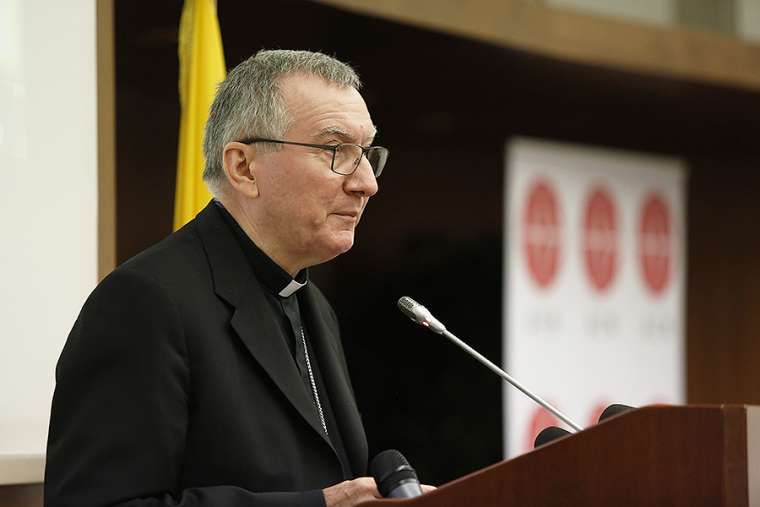Cardinal Pietro Parolin, Vatican Secretary of State, in Rome, Sept. 28, 2017. Credit: Daniel Ibanez/CNA.
A letter by Cardinal Pietro Parolin leaked to an Italian news outlet shows that the Secretariat of State was aware, and approved at its highest ranks, of the disgraced purchase of a luxury real estate property in London now at the center of a Vatican investigation.
The Italian newspaper Domani published on Jan. 10 a “confidential and urgent” letter addressed by Cardinal Parolin, Vatican secretary of State, to Jean-Baptiste de Franssu, President of the Institute for Religious Works (IOR) also known as “the Vatican bank.”
In the letter, Cardinal Parolin asked the IOR to loan 150 million € (approximately $182.3 million) to the Vatican Secretariat of State. The Secretariat of State needed the money to pay off the loan contracted with Cheney Capital four months before. The Secretariat of State took the loan to buy out the shares of the real estate in London.
Cardinal Parolin described the investment as “a valid one,” said that the investment had to be safeguarded, and asked the IOR for the loan. He also wrote that the loan was needed because the financial situation at that moment suggested the Secretariat of State not to use its reserve to “carry out operations for hedge investments,” but instead to “acquire additional liquidity.”
The Secretary of State also detailed that the loan would have a “two-year maturity” and that the IOR would be remunerated “in line with the international market” for the loan.
According to Domani, the IOR immediately move to fulfil the request and informed the Financial Intelligence Authority. The Financial Intelligence Authority has oversight power over the IOR, but not over the Secretariat of State.
In April, the Vatican FIA labelled the operation as “feasible,” considering that the IOR had enough money to carry it out. At the same time, the FIA asked for adequate due diligence to comply with existing anti-money laundering laws.
In May, Mr Gianfranco Mammì, IOR general director, asked Archbishop Edgar Peña, Sostituto of the Secretariat of State, to write down the request in a letter signed by him. According to Mammì, the Sostituto has “executive power,” and for this reason, Cardinal Parolin’s letter was not enough for the IOR to carry out the operation as requested.
Archbishop Peña Parra met the Mammì requests and signed a letter on 4 June and another one on 19 June to explain the request for the loan.
On 27 June, the IOR experts gave their green light to the financial operation. On 29 June, the IOR presented the economic plan for the loan to the officials of the Secretariat of State.
But on 2 July, Mammì changed his mind and reported to the Vatican prosecutor that Archbishop Peña Parra was not clear and would not disclose who would be the real beneficiary of the requested loan.
One Vatican source confirmed with CNA that Cardinal Parolin’s letter is authentic and that the story penned by the newspaper Domani is accurate.
After Mammì’s report to the public prosecutor, the Vatican police searched and seized the FIA and Secretariat of State’s office on 1 October 2019.
Two days later, the news broke that the Vatican had suspended five officials: Msgr. Maurizio Carlino, Mr. Fabrizio Tirabassi, Mr. Vincenzo Mauriello and Mrs. Caterina Sansone of the Secretariat of State; and Mr. Tommaso Di Ruzza, FIA director.
Later on, the Vatican also suspended Msgr. Alberto Perlasca, who led the Secretariat of State’s administrative office from 2009 to 2019.
Despite no criminal charges were filed against any of them, all of these officials, except for Caterina Sansone, no longer work at the Vatican. Di Ruzza was not renewed as the FIA’s director, Tirabassi and Mauriello agreed on an early retirement and both Carlino and Perlasca were sent to their dioceses of origin.
Although Cardinal Parolin’s leaked letter has no relevance for the investigation, it does provide important context.
One of them is that the Secretariat of State was aware that there were financial and ethical concerns regarding the 2011-2012 investment in the luxury real estate property at 60 Sloane Avenue in London, managed by 60 SA Company.
The Vatican Secretariat of State signed its purchase for $160 million with the Luxembourg-based Athena fund, owned and managed by Italian financier Raffaele Mincione, who acted as an intermediary.
When the Athena fund was liquidated, the investment was not returned to the Holy See. The Holy See risked losing all the money if it did not buy the building.
The Vatican FIA examined the deal and then proposed restructuring the investment, excluding intermediaries and thus making the Holy See save some money.
At that time, the Secretariat of State asked the IOR for resources sufficient to close the old mortgage and allow a new one to conclude the purchase.
Since the investment was initially considered “good” by the IOR, it is still a mystery what led Mammì to change his mind and report the financial operation to the public prosecutor; especially when in September 2020, the Administration of the Patrimony of the Apostolic See (APSA) reportedly paid out the loan with Cheney Capital and contracted a new loan to safeguard the investment. This was the same operation suggested by Cardinal Parolin’s letter.
So, why did the IOR not carry out the operation, as initially planned?
As more details of the operation come to light, the reason seems to be a power struggle in the inner circle of Pope Francis, with no clear winner. Currently, one year and three months after the search and seizures in the Secretariat of State, the Vatican investigation led to no indictments but also to no decisions not to prosecute. As long as the investigation leads to no clear conclusions, the scenario will continue to be confusing regarding the direction to which the Vatican finances are going.
Source: CNA

